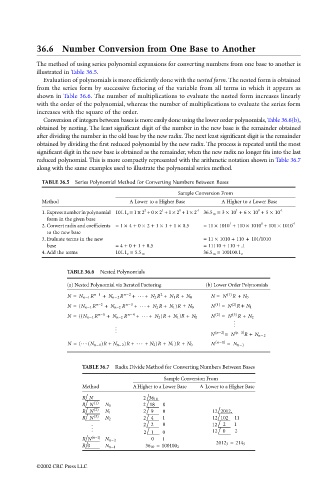Page 1035 - The Mechatronics Handbook
P. 1035
36.6 Number Conversion from One Base to Another
The method of using series polynomial expansions for converting numbers from one base to another is
illustrated in Table 36.5.
Evaluation of polynomials is more efficiently done with the nested form. The nested form is obtained
from the series form by successive factoring of the variable from all terms in which it appears as
shown in Table 36.6. The number of multiplications to evaluate the nested form increases linearly
with the order of the polynomial, whereas the number of multiplications to evaluate the series form
increases with the square of the order.
Conversion of integers between bases is more easily done using the lower order polynomials, Table 36.6(b),
obtained by nesting. The least significant digit of the number in the new base is the remainder obtained
after dividing the number in the old base by the new radix. The next least significant digit is the remainder
obtained by dividing the first reduced polynomial by the new radix. The process is repeated until the most
significant digit in the new base is obtained as the remainder, when the new radix no longer fits into the last
reduced polynomial. This is more compactly represented with the arithmetic notation shown in Table 36.7
along with the same examples used to illustrate the polynomial series method.
TABLE 36.5 Series Polynomial Method for Converting Numbers Between Bases
Sample Conversion From
Method A Lower to a Higher Base A Higher to a Lower Base
0
2
0
1
1
1. Express number in polynomial 101.1 2 = 1 x 2 + 0 × 2 + 1 × 2 + 1 × 2 -1 36.5 10 = 3 × 10 + 6 × 10 + 5 × 10 -1
form in the given base
0
1
2. Convert radix and coefficients = 1 × 4 + 0 × 2 + 1 × 1 + 1 × 0.5 = 11 × 1010 + 110 × 1010 + 101 × 1010 -1
to the new base
3. Evaluate terms in the new = 11 × 1010 + 110 + 101/1010
base = 4 + 0 + 1 + 0.5 = 11110 + 110 + .1
4. Add the terms 101.1 2 = 5.5 10 36.5 10 = 100100.1 2
TABLE 36.6 Nested Polynomials
(a) Nested Polynomial via Iterated Factoring (b) Lower Order Polynomials
2
N = N n −1 R n−1 + N n− 2 R n −2 + ··· + N 2 R + N 1 R + N 0 N = N (1) R + N 0
(2)
N = (N n−1 R n−2 + N n−2 R n−3 + ··· + N 2 R + N 1 )R + N 0 N (1) = N R + N 1
N = ((N n−1 R n−3 + N n−2 R n− 4 + ··· + N 2 )R + N 1 )R + N 0 N (2) = N (3) R + N 2
·
. · ·
.
. )
n 3
−
N (n 2) = N ( − R + N n−2
R
N = (··· (N n −1 ) + N n− 2 )R + ··· + N 2 )R + N 1 )R + N 0 N (n−1) = N n −1
TABLE 36.7 Radix Divide Method for Converting Numbers Between Bases
Sample Conversion From
Method A Higher to a Lower Base A Lower to a Higher Base
RN 236 10
R N (1) N 0 2 18 0
R N (2) N 1 2 9 0 12 2012
3
(3)
R N N 2 2 4 1 12 2 1
12 102 11
2 2 0
· ·
· 2 1 0 12 0 2
RN (n−1) N n−2 0 1
2012 3 = 214 5
R 0 N n−1 36 10 = 100100 2
©2002 CRC Press LLC

